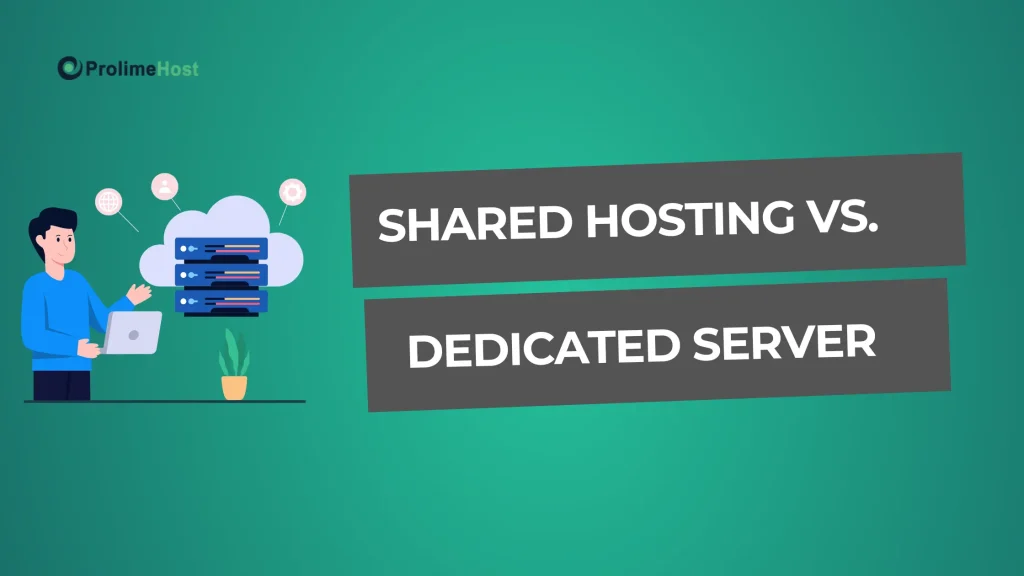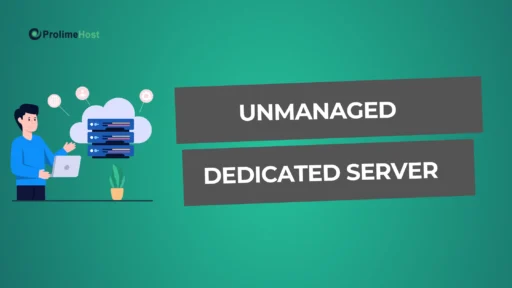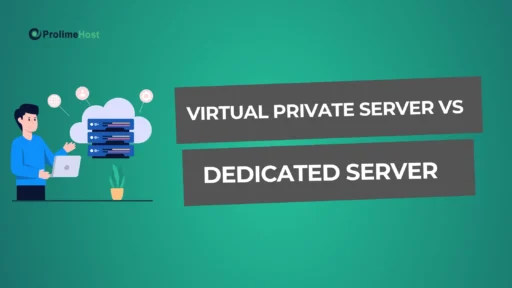
Starting a website? You’ve got to pick the right hosting. Shared hosting works when you’re just getting started. It’s cheap. Easy. Good enough for a blog or portfolio.
But once more people start visiting your site, things break down. Pages load slow. Security gets shaky. And you’ve got zero control over what’s going on behind the scenes.
That’s when you need to level up. A dedicated server gives you what shared hosting can’t. You control everything. No more sharing resources with strangers. Your site stays fast, stable, and locked down.
Need a provider that actually delivers? Come with ProlimeHost. We give you real, bare-metal dedicated servers. Uptime stays solid. Their team’s around 24/7 if anything goes wrong. You get help moving your site over. And we will build the setup around what your site actually needs.
If your site’s growing, don’t wait. Make the switch to ProlimeHost. Let your hosting keep up.
TL;DR – Shared Hosting vs. Dedicated Server
| Shared Hosting | Dedicated Server | |
| Pros | -Affordable for beginners -Easy to set up and manage -No technical skills required -Good for basic websites | -Full control over all server resources -High performance and speed consistency -Custom security and software setup -Dedicated IP and better uptime reliability |
| Cons | -Shared resources may impact performance -Limited security controls -Less customization No dedicated IP (usually) | -Higher cost -Requires technical knowledge or managed support -Manual scaling can be complex -Maintenance burden (unless managed) |
| Best For | -Beginners and small website owners -Low-traffic blogs or portfolios -Users seeking a simple, budget-friendly setup | -Large businesses and ecommerce platforms -High-traffic or resource-heavy websites -Teams needing full control, speed, and custom configurations |
What is Shared Hosting?

Shared hosting is one of the most popular and budget-friendly types of web hosting, ideal for beginners and small websites. In this setup, multiple websites share the same physical server and its resources, like CPU, RAM, and storage.
This shared environment helps keep costs low, but it also means limited control and scalability. It’s a great starting point if your site has modest traffic and minimal technical demands.
What is Linux Shared Hosting?

Linux shared hosting refers to a shared hosting environment that uses the Linux operating system. Developers and website owners favor it for its stability, speed, and compatibility with popular web technologies like PHP, MySQL, Python, and WordPress.
Since Linux is open-source, hosting providers don’t have to pay licensing fees: making Linux hosting more affordable than its Windows counterpart.
How Shared Hosting Works?
Cost-Effective: No OS licensing fees means cheaper hosting.
Developer-Friendly: Supports cPanel, FTP, and a wide range of scripts.
Secure & Reliable: Known for strong community support and fewer vulnerabilities.
Ideal for Open Source CMS: Works seamlessly with WordPress, Joomla, Drupal, etc.
What is a Dedicated Server?
- A dedicated server is a real, physical machine that’s all yours.
- No sharing. You get 100% of the CPU, RAM, storage, and bandwidth.
- Unlike shared or VPS hosting, no other users slow you down.
- These servers sit in secure data centers.
- You can manage everything yourself or let the provider handle it.
- You choose the OS, set up software, and control all security settings.
Key features:
- Full access to all server resources
- Root-level control
- Stable, reliable performance
- Great for high traffic, custom apps, or compliance-heavy sites
Why Use a Dedicated Server?
1. Performance
You don’t share resources, so your site runs faster.
No “noisy neighbors” using up bandwidth or CPU.
2. Full control
Pick your OS. Install what you want.
Tune performance and set custom rules.
3. Strong security
No other users on your machine = less risk.
You control encryption, firewalls, and access.
4. Easy to scale
Add more RAM or storage as you grow.
You can even build hybrid setups or clusters.
How to Set up a Dedicated Server
1. Choose a provider
Go with a trusted host that offers solid hardware and uptime.
Check for custom options and room to upgrade.
2. Pick your OS
Use Linux (Ubuntu, CentOS, Debian) or Windows Server.
Most hosts let you choose during setup.
3. Install software
Add web servers like Apache or Nginx.
Install databases and any tools your app needs.
4. Lock it down
Create user roles.
Enable firewalls. Close unused ports. Add malware protection.
Set up backups and monitoring.
5. Deploy your site or app
Upload files using FTP or Git.
Point your domain to the server IP.
Test everything.
6. Manage the server
If unmanaged, handle updates, logs, and backups yourself.
If managed, your provider takes care of it.
Relevant Characteristics Between Dedicated Server and Shared Hosting
Your hosting choice directly affects how your website performs and grows. Use this quick comparison to see how dedicated servers and shared hosting stack up.
| Characteristic | Dedicated Server | Shared Hosting |
| Resource Allocation | Full server resources are exclusively allocated to you | Resources are shared with multiple users on the same server |
| Performance | High performance with consistent speed and reliability | Performance may vary depending on other users’ activities |
| Security | Higher security and customization options | Basic security; vulnerable to risks from other websites |
| Customization | Full control over OS, software, and configurations | Limited customization; usually predefined server setup |
| Scalability | Can scale with hardware upgrades or configuration changes | Limited scalability; suitable for small websites |
| Cost | More expensive due to exclusive access | Affordable and cost-effective for beginners |
| Technical Expertise | Requires server management skills (or a managed plan) | Little to no technical knowledge required |
| Use Case | Best for high-traffic websites, large apps, or enterprises | Suitable for small blogs, portfolios, or startups |
| IP Address | Usually comes with a dedicated IP | Typically shares IP with other websites |
| Downtime Risk | Lower risk due to isolated environment | Higher risk from others’ issues affecting the server |
Similarities and Differences
Dedicated Server and Shared Hosting Differences
When choosing a web hosting plan, it’s important to understand the core differences between shared and dedicated hosting. Your website’s performance, scalability, and security depend on it.
What is Shared Hosting?
Shared hosting means multiple websites are hosted on the same physical server. All users share resources like CPU, RAM, and disk space.
Pros of Shared Hosting
- Budget-friendly and ideal for beginners.
- Easy to set up with minimal technical skills.
- Managed maintenance and updates by the hosting provider.
Cons of Shared Hosting
- Limited resources can lead to performance issues during traffic spikes.
- Less control over server configurations.
- Potential security risks from neighboring sites.
What is Dedicated Hosting?
Dedicated hosting gives you an entire server exclusively for your website. You control hardware configurations, software, and resource allocation.
Pros of Dedicated Hosting
- High performance, even during peak traffic.
- Complete control over the server environment.
- Enhanced security and privacy.
Cons of Dedicated Hosting
- Significantly more expensive than shared hosting.
- Requires technical expertise to manage (unless it’s a managed plan).
Quick Comparison – Shared Hosting vs. Dedicated Hosting
| Feature | Shared Hosting | Dedicated Hosting |
| Resource Allocation | Shared with others | Exclusive to one user |
| Cost | Low | High |
| Control & Customization | Limited | Full root access and customization |
| Security | Shared vulnerabilities | Enhanced, customizable security |
| Performance | Can slow with high traffic | Stable even under high load |
| Ideal For | Small sites, blogs, basic business sites | High-traffic sites, enterprise-level apps |
When to Choose Shared Hosting
- You’re starting a blog, portfolio, or basic business site.
- Budget is tight.
- You don’t need high performance or heavy customizations.
When to Choose Dedicated Hosting
- You run a high-traffic eCommerce, SaaS, or media-heavy site.
- Your website handles sensitive data and requires strict security.
- You need custom server configurations or advanced software installations.
Dedicated Server and Shared Hosting Similarities
While shared and dedicated hosting serve different needs, they still share some foundational traits. Here are the core similarities between the two:
1. Web Hosting Purpose
Both types of hosting are designed to make your website accessible online. Whether shared or dedicated, the server stores your website’s files and delivers them to users when they visit your domain.
2. Internet Connectivity
Both shared and dedicated servers rely on high-speed data centers with 24/7 internet connectivity to ensure your site stays live and accessible globally.
3. Use of Control Panels
Most hosting providers, regardless of the hosting type, offer intuitive control panels like cPanel or Plesk for managing your site, domains, databases, and email accounts.
4. Server-Side Technologies
Both plans support standard web technologies such as:
- PHP, Python, or Node.js
- MySQL or PostgreSQL databases
- SSL Certificates
- FTP access
5. Uptime Guarantees
Hosting companies typically offer uptime commitments (e.g., 99.9%) for both shared and dedicated servers to ensure reliability for all customers.
6. Provider-Level Support
Whether you’re on a shared plan or a dedicated server, most hosting companies offer technical support, often via live chat, email, or ticket systems.
Common Myths About Shared Hosting and Dedicated Servers
Confused by what’s true and what’s hype in hosting? Let’s clear up the biggest myths.
Myth 1: Shared Hosting and Free Hosting are the Same
Wrong. Free hosting lacks support and control.
Shared hosting gives you basic features, support, and stability.
Myth 2: Shared Hosting isn’t Secure
It can be secure if you pick the right provider.
Firewalls, SSL, and malware scans are standard on good plans.
Myth 3: Shared Hosting can’t Scale
Some shared plans let you upgrade resources.
Works well for beginners and small sites.
Myth 4: Dedicated Servers Need Deep Tech Skills
Not always. Managed plans handle everything for you.
You get control without the hassle.
Myth 5: Dedicated Servers are Too Expensive
They cost more, but plans now fit different budgets.
You don’t need enterprise money to start.
Myth 6: VPS and Dedicated Servers are the Same
They’re different. VPS still shares hardware.
Dedicated servers give you everything, no sharing.
How to Migrate from Shared Hosting to a Dedicated Server
Upgrading to a dedicated server fixes slow load times, traffic issues, and weak security. Here’s exactly how to move without breaking anything.
Step 1: Check What You’re Running Now
Look at your website size, daily traffic, server resource usage, and app dependencies.
List out everything: CMS, plugins, databases, emails, cron jobs, and file paths.
Know what’s working well and what needs improvement.
Step 2: Pick a Dedicated Hosting Provider
Choose a provider that gives you:
- High uptime (99.9% or more)
- Scalable hardware options
- 24/7 support
- Managed server plans if needed
Check user reviews. Avoid hidden fees. Look for plans that let you upgrade hardware without downtime.
ProlimeHost is a solid option, we help set up custom configurations based on your workload.
Step 3: Back Up Everything
Make full backups of:
- Website files (HTML, PHP, images, CSS, JS)
- Databases (MySQL, PostgreSQL, etc.)
- Email accounts and settings
- DNS zone files and custom records
Store them on both a local device and cloud storage. Don’t skip this.
Step 4: Set Up the New Dedicated Server
Work with your host or sysadmin to install:
- Operating System (Linux or Windows Server)
- Web server (Apache, Nginx, or IIS)
- Required databases and software
- SSL, firewalls, malware scanners, and backups
Make sure the settings match your old server to avoid conflicts.
Step 5: Move Your Site and Applications
Use FTP, SCP, SSH, or migration tools (like cPanel or plugins) to transfer:
- Public files
- Config files
- Database exports/imports
Update any hard-coded paths, environment variables, and file permissions.
Step 6: Test Before You Go Live
Check everything:
- Website loads without errors
- Forms, search bars, login pages, and carts work
- Mobile and desktop speed is good
- SSL is active and links are secure
- Email sending/receiving works
Fix any issues before moving traffic.
Step 7: Point Your Domain to the New Server
Update your DNS A records to the new server’s IP.
DNS changes can take up to 48 hours to fully update.
Do this during low-traffic hours to reduce user impact.
Done Right, You Get:
- Faster site performance
- Stronger security
- Total control over the server
- Space to scale up anytime
Want a host that helps you with setup and migration?
Check out ProlimeHost, we offer hands-on support and custom builds for growing sites.
What About Virtual Private Server?
A VPS gives you dedicated resources (CPU, RAM, storage) inside a shared physical server.
It’s the middle option between shared hosting and a full dedicated server.
What Is VPS Used For?
- Hosting websites that need more power than shared plans
- Running custom apps or software stacks
- Hosting multiple sites or client projects
- Storing sensitive data with better isolation
VPS vs. Other Hosting Types
| Hosting Type | Resources | Control | Cost | Use Case |
| Shared Hosting | Shared by all | Very limited | Low | Basic websites, entry-level use |
| VPS Hosting | Private section | High | Moderate | Developers, growing businesses |
| Dedicated Server | Fully exclusive | Full root access | High | Large apps, enterprise projects |
Why Choose VPS Hosting?
- Scalable – Upgrade resources anytime
- Secure – No other users affect your server
- Customizable – Install OS, software, and tools
- Cost-Effective – More power without the high price
Types of VPS Hosting
- Unmanaged VPS – You handle setup, updates, and security
- Managed VPS – Provider handles most tasks
- Semi-managed VPS – Mix of self-control and support
Bottom Line – Which One Suits You the Best
Your hosting choice depends on what your website truly needs: speed, control, scalability, or all three.
If you’re managing high-traffic sites, mission-critical apps, or complex workloads, switching to a dedicated server makes the most sense. And when it comes to dedicated hosting, ProlimeHost leads the way.
ProlimeHost delivers more than just servers, it powers your growth with custom solutions designed for performance and reliability. Whether you’re scaling a startup or running an enterprise platform, ProlimeHost gives you the infrastructure and support to stay ahead.
Why ProlimeHost stands out?
Delivers high-performance servers tailored to your workload
Operates globally with fast, secure data centers in the US, Europe, and Asia
Manages your hosting if you want a hands-free experience
Offers transparent pricing you pay only for what you need
Supports you 24/7 with real-time expert assistance via live chat and phone
You get the speed, flexibility, and security your business demands, backed by a team that treats your success like their own.
Choose ProlimeHost and experience dedicated hosting that’s built to perform, scale, and support you every step of the way.
Frequently Asked Questions (FAQs)
Is Shared Hosting Good For E-commerce?
Shared hosting can work for small e-commerce stores with low traffic and basic functionality. However, for faster load times, better security, and smoother checkout experiences, a VPS or dedicated server is a smarter long-term choice, especially as your store grows.
Is Shared Hosting Good for a New Website?
Yes. Shared hosting is ideal for beginners, personal blogs, and small business websites. It’s affordable, easy to set up, and typically comes with tools like cPanel and one-click installs, making it a great starting point.
Can I Upgrade From Shared Hosting to a Dedicated Server Later?
Absolutely. Most hosting providers, including ProlimeHost, allow seamless upgrades. As your traffic, data, or performance needs increase, you can migrate to a VPS or dedicated server without starting from scratch.
How Much Traffic Can a Dedicated Server Handle?
A dedicated server can handle hundreds of thousands to millions of monthly visits, depending on your server configuration and website optimization. It’s built for high-performance workloads and resource-intensive applications.
Does Shared Hosting Affect Website Speed?
Yes. In shared hosting, multiple websites share the same server resources. If one site uses too much bandwidth or processing power, it can slow down others. For consistently fast speeds, consider VPS or dedicated options.



